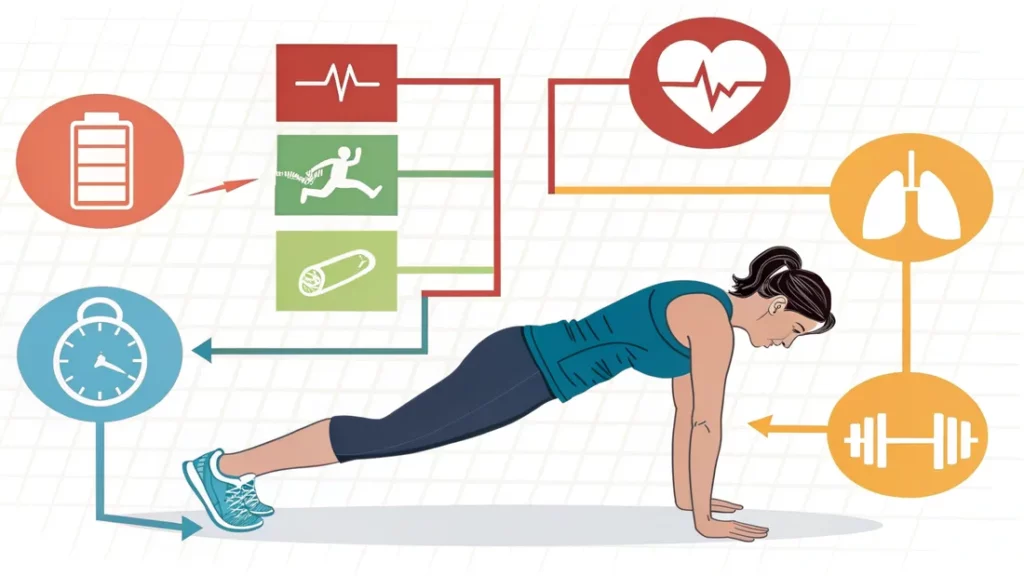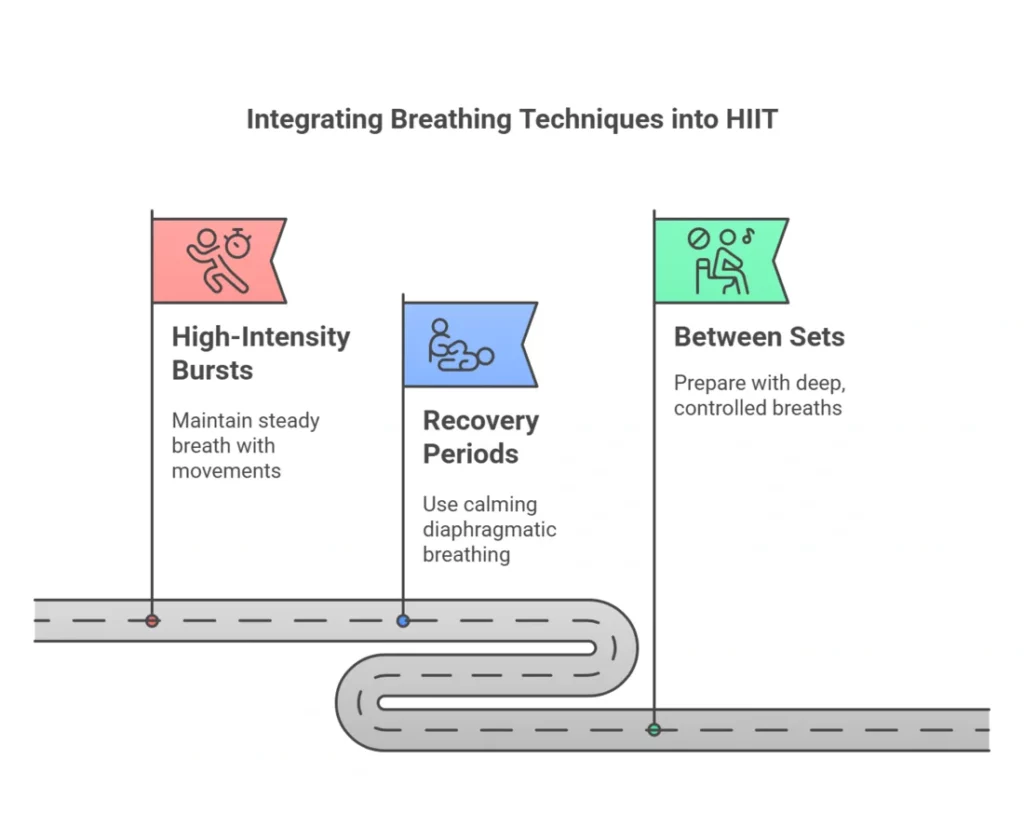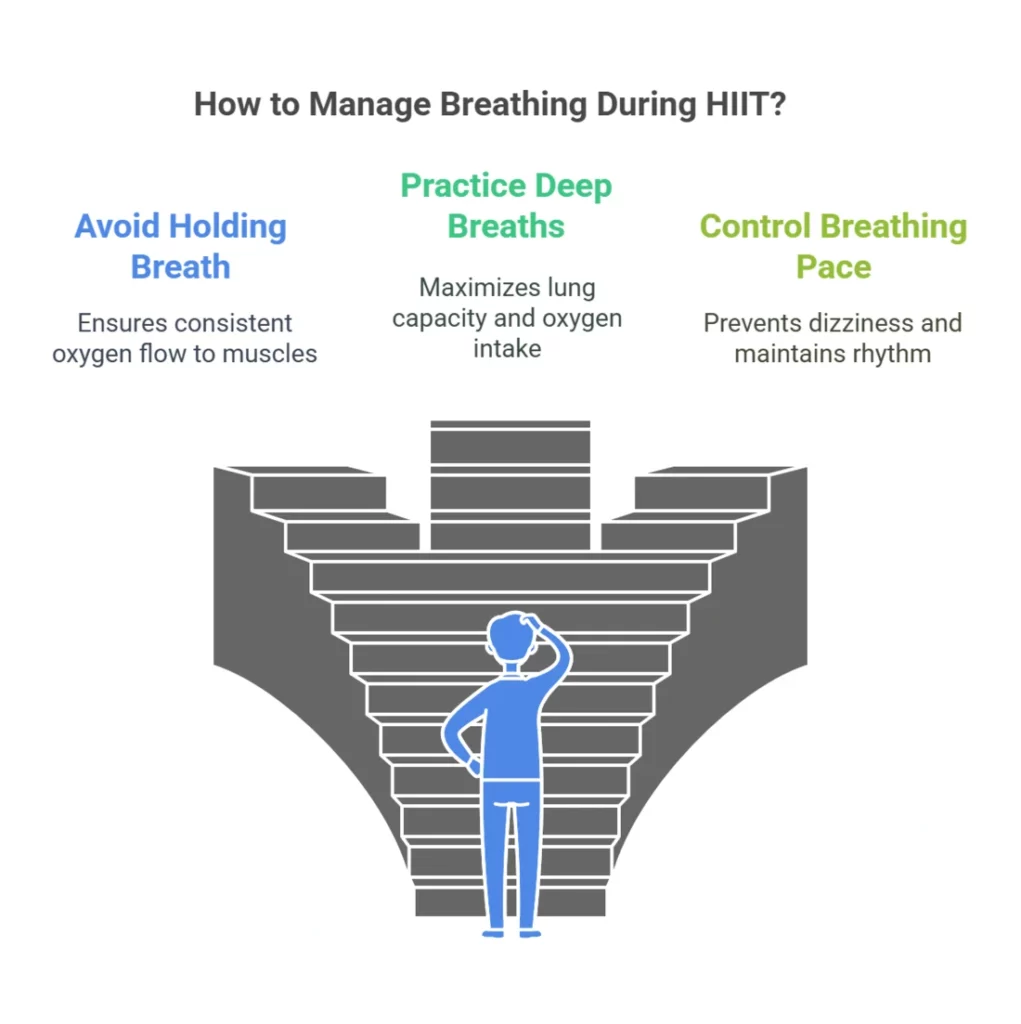Are you ready to take your HIIT workouts to the next level?
If you’ve been pushing your limits but still feel like you’re hitting a plateau, or if you’re simply looking for new ways to enhance your intensity and endurance, then you’ve come to the right place.
The key to unlocking greater results might be found in something you are already doing: breathing.
This is why we will be delving into the world of breathing exercises for HIIT workouts.

By implementing new breathing methods into your routine, you will unlock a powerful tool for increasing intensity, maximizing your stamina, and achieving peak performance.
This guide will equip you with the knowledge and the tools you need to make your next HIIT workout your best one yet.
The Relationship Between Breathing and HIIT Workouts
To truly understand the importance of proper breathing for HIIT workouts, it’s vital to explore the core relationship between these two concepts.
While HIIT may be all about high-intensity exercise, breathing is an integral part of this experience.
Let’s unpack why this is so important.

Key Concepts
- Understanding HIIT:
- High-Intensity Interval Training (HIIT) involves short bursts of intense exercise, followed by periods of recovery. This type of training is designed to push your body to its limits, which makes it an incredibly useful tool for enhancing your fitness journey, and also for burning calories effectively. This is why proper breathing techniques are so important.
- Why Proper Breathing is Essential:
- During HIIT workouts, your muscles require a large supply of oxygen to work effectively, and proper breathing will help with oxygen delivery. By breathing in a controlled manner, you are ensuring that your body is receiving what it needs, which will also help to maintain your overall energy levels. In turn, this will help you to maintain your muscle endurance throughout your workout, and also prevent injury by engaging your core properly.
- If you are not using the correct methods of breathing, you may not be reaching your full potential, and also be causing more harm than good.
- The Effect of Poor Breathing on HIIT:
- Incorrect or inefficient breathing during HIIT workouts can have a negative impact on your overall fitness experience. It can lead to feelings of fatigue, shortness of breath, and also impact your overall performance levels.
- You may also start to feel your muscles tense, which can cause injury. Therefore, it is vital that you understand how to manage your breathing, to get the most out of your workouts.
This has been backed by research which shows the importance of proper breathing to allow your muscles to receive the oxygen and energy they need to perform effectively [https://www.houstonmethodist.org/blog/articles/2023/may/why-proper-breathing-during-exercise-is-important-how-to-avoid-common-mistakes/].
Breathing Exercises To Enhance Your HIIT Workouts
Now that you understand the importance of breathing in HIIT workouts, let’s dive into some specific techniques that can help you to maximize your performance.
These are methods that can be easily implemented in your daily life, and that will help you to see an improvement in your workouts.

Key Techniques
- Technique 1: Paced Breathing for HIIT
- How to do it:
- Begin with a warm up to get your body moving and prepare yourself for action.
- As you are performing the high-intensity bursts, try to synchronize your breath with your movements. For example, try to inhale for two steps, and then exhale for two steps.
- This method should help you to create a rhythm, and you can also adjust your breathing to make sure it works for you.
- How it helps in HIIT: Paced breathing helps to maintain oxygen delivery throughout your body, and also ensures you are managing your energy output effectively. This will help you to focus on getting through your workout, rather than being distracted by your breathing.
- Technique 2: Breath Stacking
- How to do it:
- Breath stacking involves taking multiple short inhales before slowly exhaling. You can achieve this by taking three short inhales, followed by one long exhale.
- You can also use this method in between sets, or as a post workout recovery method.
- How it helps in HIIT: Breath stacking can help to increase the oxygen saturation in your lungs, which helps you to make use of more oxygen during your workout, and also to help with your muscle recovery afterwards. This method is also designed to help you maintain focus, and manage the stress you may feel after a workout.
- Technique 3: Diaphragmatic Breathing for Recovery
- How to do it:
- Find a comfortable place to either lie down or sit.
- Place one hand on your chest and the other on your belly, to see how your body moves.
- Focus on inhaling deeply through your nose, while allowing your belly to rise, and your chest to remain relatively still.
- Exhale slowly, and allow your belly to fall.
- Repeat this cycle for a few minutes.
- How it helps in HIIT: Diaphragmatic breathing is a fantastic tool for reducing stress and promoting relaxation after an intense HIIT workout. This technique helps to enhance muscle relaxation and is an ideal tool for the post workout cool down and to start your recovery journey.
How to Implement Breathing into Your HIIT Routine
Now that you’re familiar with the core breathing techniques, let’s explore how you can seamlessly integrate them into your HIIT workouts.
It’s not about completely changing your routine, it is about enhancing each section with these methods to make the whole process even more effective.

Key Implementation Strategies
- During the High-Intensity Bursts:
- When you are performing your high-intensity bursts, it is vital to maintain a steady pace with your breath. It is best to implement paced breathing, which involves coordinating your breath with your movements. As you explode with power, exhale, and as you are relaxing, you should inhale. This will ensure that you are not using all your energy at once, and will help you to push through to the next section.
- It’s also important to focus on controlled breaths, rather than taking shallow or rapid breaths, which may cause you to feel overwhelmed.
- During Recovery Periods:
- During your recovery periods, use a more calming breathing method, such as diaphragmatic breathing, to help bring your body back to a more relaxed state. This will help you to prepare for the next set, whilst also helping you to manage any stress that you may feel. Try to spend a few minutes focusing on your breath, rather than rushing from one burst to another.
- If you are feeling tense or stressed, also try practicing breath awareness, which will help you to connect more with your body and mind.
- Between Sets:
- In between your sets, it is useful to prepare yourself for the next movement, by taking deep and controlled breaths. This can include using belly breathing, which is a great method for preparing your body.
- This will also act as a form of mental preparation, and allow you to focus on what is to come, rather than rushing from one point to the next. Try to create space for mindfulness throughout your entire workout journey.
Common Mistakes and How To Avoid Them
Even when you are trying to use the best breathing methods for HIIT, it is very common to make some mistakes along the way.
To ensure you are avoiding these pitfalls, and not hindering your performance, let’s explore the common breathing errors that people make during HIIT workouts, and how you can rectify them, to reach your true potential.

Key Mistakes and Solutions
- Holding Your Breath:
- Explanation: Holding your breath during high-intensity bursts, is a very common mistake that you may not even realize you are doing. This is your body’s natural response to strenuous activity, but it can have a negative impact. This will create tension, and will also reduce the amount of oxygen that you are delivering to your muscles.
- How to Avoid It: You can avoid this problem by focusing on taking consistent breaths, and also by implementing paced breathing, to ensure that your breath is always flowing throughout your movements. When you are doing this, you are allowing your body to receive oxygen throughout your entire workout routine.
- Shallow Breaths:
- Explanation: Taking short, shallow breaths is another common mistake that people make, and can have a massive impact on your workouts. When you are not taking deep and full breaths, you are reducing your body’s ability to receive all of the necessary oxygen and also expel carbon dioxide. This will lead to fatigue, and will also reduce your overall stamina.
- How to Avoid It: Focus on taking longer, deeper breaths, which will help to ensure that you are maximizing your lung capacity. You can also focus on belly breathing, to ensure you are drawing air fully into your body.
- Over Breathing (Hyperventilation):
- Explanation: Another mistake that people can often make, is to over breathe. This can occur when you are pushing yourself too hard, or when your body feels like it needs to perform faster. Over breathing or hyperventilation will lead to breathlessness, dizziness and also tension in the body.
- How to Avoid It: Try to take slow and consistent breaths, and implement paced breathing to ensure that you are not pushing yourself too hard. You should also stop and take a break when you feel lightheaded or dizzy and focus on taking deeper breaths to rebalance your body.
Frequently Asked Questions About Breathing for HIIT
To make sure you feel confident and well-informed on the topic of breathing for HIIT, let’s take a look at some of the most frequently asked questions that people have.
These questions are designed to help you further improve your knowledge, and your overall approach to breathing.
- Question 1: How to breathe during HIIT workouts?
- Answer: When performing HIIT workouts, it is important to focus on using a combination of paced breathing during the high-intensity bursts, followed by diaphragmatic breathing during the recovery periods. The key is to find a technique that works best for you, and to implement it with consistency. Over time you will be able to control your breathing with greater ease.
- Question 2: Does diaphragmatic breathing improve HIIT?
- Answer: Diaphragmatic breathing, also known as belly breathing, is great for helping to improve your overall HIIT performance, as it helps to deliver oxygen more effectively to the muscles. This is best implemented during the recovery periods, to help reduce stress and to also improve your body’s ability to relax. However, it can also be used throughout your workout, and you should try and test what works best for your body.
- Question 3: How can breathing techniques increase your stamina?
- Answer: Breathing techniques help to increase your stamina by improving your body’s ability to use oxygen effectively, to also conserve energy, and also help to reduce fatigue. By focusing on paced breathing and diaphragmatic breathing you will ensure that you are using these powerful tools correctly, to improve your fitness journey.
- Question 4: How does breathing affect recovery after HIIT?
- Answer: Proper breathing plays a vital role in recovery after HIIT by helping to clear waste products such as lactic acid from the muscles. It is also essential for reducing stress hormones in the body, and promoting a state of calm, which will in turn help your body to repair and also improve your overall performance. This is why the cool-down is just as important as the workout itself.
My Final Thoughts on Breathing For HIIT Workouts
As we reach the end of this guide to breathing for HIIT, I hope you now have a better understanding of how important it is to incorporate proper breathing techniques into your routine.
By using this method, you are well on your way to improving your overall performance and enhancing your fitness journey.
We’ve explored the core relationship between breathing and HIIT workouts, as well as several practical and actionable methods that can be implemented in all aspects of your fitness routine.
By using paced breathing, breath stacking and diaphragmatic breathing, you are making an active effort to improve your fitness journey.
You should also understand that common breathing mistakes are common, and by taking the time to address them, you are taking the first step to improve your workouts.
I encourage you to start implementing these simple yet effective methods into your routine, and to make mindful breathing a part of your daily life.
As you take control of your breath, you will also begin to unlock your full potential.
I wish you all the best for your future workouts and I hope that you see amazing results.
Now, go forth and breathe!
Related Posts
No posts
